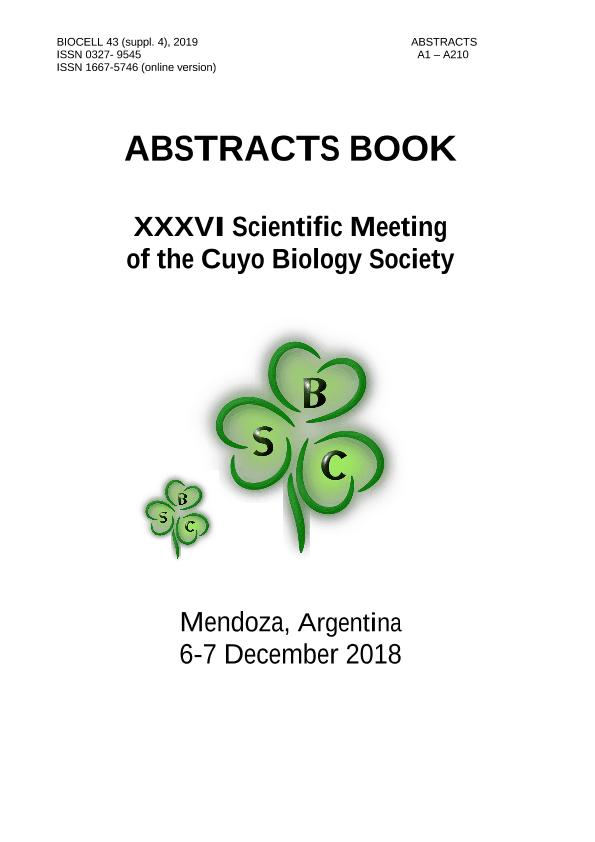Mostrar el registro sencillo del ítem
dc.contributor.author
Argüello, Eva Alfonsina
dc.contributor.author
Filippa, Veronica Palmira

dc.contributor.author
Perez, Edith

dc.contributor.author
Mohamed, Fabian Heber

dc.date.available
2022-06-29T20:43:43Z
dc.date.issued
2019
dc.identifier.citation
Circadian variations in the expression of estrogen receptor alfa in retina of viscacha; XXXVI Reunión Científica Anual de la Sociedad de Biología; Mendoza; Argentina; 2018; 17-17
dc.identifier.issn
0327-9545
dc.identifier.uri
http://hdl.handle.net/11336/160840
dc.description.abstract
In some species the presence of estrogen receptors α (ERα) has been demonstrated in retina. ERα are involved in neuroprotectivefunctions through their ability to regulate apoptosis, autophagy and antioxidant processes. Morphological variations in the retinallayers of viscacha have been demonstrated in response to changes in ambiental lighting. The objective of our work was to study theexpression of ERα in retina according to the morphological variations described previously. Retinas of adult male viscachas(Lagostomus maximus maximus) were obtained at 08:00, 16:00, and 24:00 h (n = 4 for each group). They were processed for lightmicroscopy and histological sections were made for the immunohistochemistry with the primary antibody anti-ERα (MC20): sc-542.The visualization of reaction was performed using an amplified biotin-streptavidin system (DAB chromogen). The immunoreactive (-ir) cells were quantified by image analysis and the number cell was expressed by microscopic field (cell/field). The data wasstatistically analyzed. In retinas from viscachas sacrificed at 08:00 h, intense nuclear immunostaining was observed in cells of theinner nuclear layer (INL) and in retinal ganglion cells (RGC). At 16:00 h, the ERα were not expressed in the retinal layers. However,in samples obtained at 24:00 h was observed nuclear labeling less intense in the INL and RGC. The morphometrical study revealedthat the number ERα-ir cells in the INL was significantly increased at 08:00 h (15.52 ± 2.90 cell/field) compared to the correspondingvalues at 24:00 h (4.45 ± 0.92 cell/field, p < 0.05). In addition, the number of RGC that express ERα were higher at 8:00 h (0.96 ±0.25 cell/field) compared to those obtained at 24:00 h (0.20 ± 0.05 cell/field, p < 0.05). These results show that the expression of ERαis detected at 24:00 h when the photoreceptor layer (PL) thickness was maximal. The expression of ERα reaches a maximum at 8:00h when the thickness of the PL began to decrease and they are absent when the thickness of the PL was minimal. This suggests thatERα expressed in INL and RGC might be involved in processes that regulate autophagy and the daily photoreceptor renewal cyclethrough the specific connections established into the retinal layers. However, future studies will be necessary to elucidate the role ofERα in viscacha retina.
dc.format
application/pdf
dc.language.iso
eng
dc.publisher
Instituto de Histología y Embriología

dc.rights
info:eu-repo/semantics/openAccess
dc.rights.uri
https://creativecommons.org/licenses/by-nc-sa/2.5/ar/
dc.subject
CIRCADIAN VARIATIONS
dc.subject
ESTROGEN RECEPTOR
dc.subject
RETINA
dc.subject
VISCACHA
dc.subject.classification
Biología

dc.subject.classification
Ciencias Biológicas

dc.subject.classification
CIENCIAS NATURALES Y EXACTAS

dc.title
Circadian variations in the expression of estrogen receptor alfa in retina of viscacha
dc.type
info:eu-repo/semantics/publishedVersion
dc.type
info:eu-repo/semantics/conferenceObject
dc.type
info:ar-repo/semantics/documento de conferencia
dc.date.updated
2022-06-28T14:56:05Z
dc.identifier.eissn
1667-5746
dc.journal.volume
43
dc.journal.number
4
dc.journal.pagination
17-17
dc.journal.pais
Argentina

dc.journal.ciudad
Mendoza
dc.description.fil
Fil: Argüello, Eva Alfonsina. Universidad Nacional de San Luis. Facultad de Química, Bioquímica y Farmacia. Departamento de Bioquímica y Ciencias Biológicas; Argentina. Consejo Interuniversitario Nacional. - Ministerio de Educación, Cultura, Ciencia y Tecnología. Consejo Interuniversitario Nacional; Argentina
dc.description.fil
Fil: Filippa, Veronica Palmira. Consejo Nacional de Investigaciones Científicas y Técnicas. Centro Científico Tecnológico Conicet - San Luis; Argentina. Universidad Nacional de San Luis. Facultad de Química, Bioquímica y Farmacia. Departamento de Bioquímica y Ciencias Biológicas; Argentina
dc.description.fil
Fil: Perez, Edith. Universidad Nacional de San Luis. Facultad de Química, Bioquímica y Farmacia. Departamento de Bioquímica y Ciencias Biológicas; Argentina
dc.description.fil
Fil: Mohamed, Fabian Heber. Universidad Nacional de San Luis. Facultad de Química, Bioquímica y Farmacia. Departamento de Bioquímica y Ciencias Biológicas; Argentina
dc.relation.alternativeid
info:eu-repo/semantics/altIdentifier/url/https://sbcuyo.org.ar/reuniones-anuales-anteriores/
dc.conicet.rol
Autor

dc.conicet.rol
Autor

dc.conicet.rol
Autor

dc.conicet.rol
Autor

dc.coverage
Nacional
dc.type.subtype
Reunión
dc.description.nombreEvento
XXXVI Reunión Científica Anual de la Sociedad de Biología
dc.date.evento
2018-12-06
dc.description.ciudadEvento
Mendoza
dc.description.paisEvento
Argentina

dc.type.publicacion
Journal
dc.description.institucionOrganizadora
Sociedad de Biología de Cuyo
dc.description.institucionOrganizadora
Universidad Nacional de Cuyo. Secretaría de Extensión Universitaria
dc.source.revista
Biocell

dc.date.eventoHasta
2018-12-07
dc.type
Reunión
Archivos asociados
